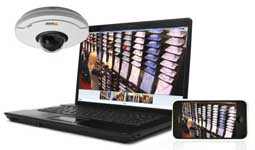Rail sector CCTV needs have changed according to a product manufacturer. Faced with a battle against onboard violence and vandalism, rail authorities have an increasing need for surveillance, on trains and at stations, to help protect staff and passengers as well as the infrastructure to ensure services keep running.
David Thomasson, Northern Europe transportation business development manager, at network CCTV product firm Axis Communications said: “The surveillance needs of the rail sector are diverse and extremely complex and have changed over the last decade.
“Cable theft is increasingly a major security issue for this sector. The British Transport Police has claimed that it is their second highest priority after terrorism and Network Rail revealed that its passengers were delayed by a total of 6,088 hours last year because of it.
“Rail authorities continue to fight an array of security issues on a daily basis, while customers expect the same level of security protection from the moment they arrive at the station to start their journey until they disembark at their destination.”
“Rail authorities also have to meet the diverse surveillance needs of various organisations. The station could be owned by one company, the trains operated by another and the infrastructure, track and tunnels owned by yet another. The range of functionality offered by network video cameras can help the disparate organisations that operate a rail network meet many of these surveillances challenges they face.”
The role played by surveillance in providing the vital footage which underpins all of these organisations’ needs from security, safety and operational management functions is crucial, the firm adds.
Network video cameras offer rail authorities a variety of functionality that can provide onboard surveillance, help solve footage storage issues and provide detection in difficult light the company says:
* Corridor format – In many surveillance situations, a rail operator may need to monitor an area that is more vertical than horizontal in shape, eg platforms, passageways and escalators. The traditional landscape format is not the optimal solution as it creates video streams where a large part of the field of view – specifically the sides of the image – is redundant. Network video enables corridor format and helps to maximise the field of view and potentially reduce the number of cameras required.
* Edge storage – This is where the recorded video is stored, ‘onboard’ the camera. It is particularly useful for remote locations where there is intermittent or no network availability.
* Thermal imaging – Detection is a fast growing area of surveillance and thermal cameras offer 24×7 detection in extreme conditions such as darkness, smoke and areas in shadow.
To hear David Thomasson talk about the complex surveillance needs of the rail sector and how network video can help, go to this link:










